All products featured are independently chosen by us. However, SoundGuys may receive a commission on orders placed through its retail links. See our ethics statement.
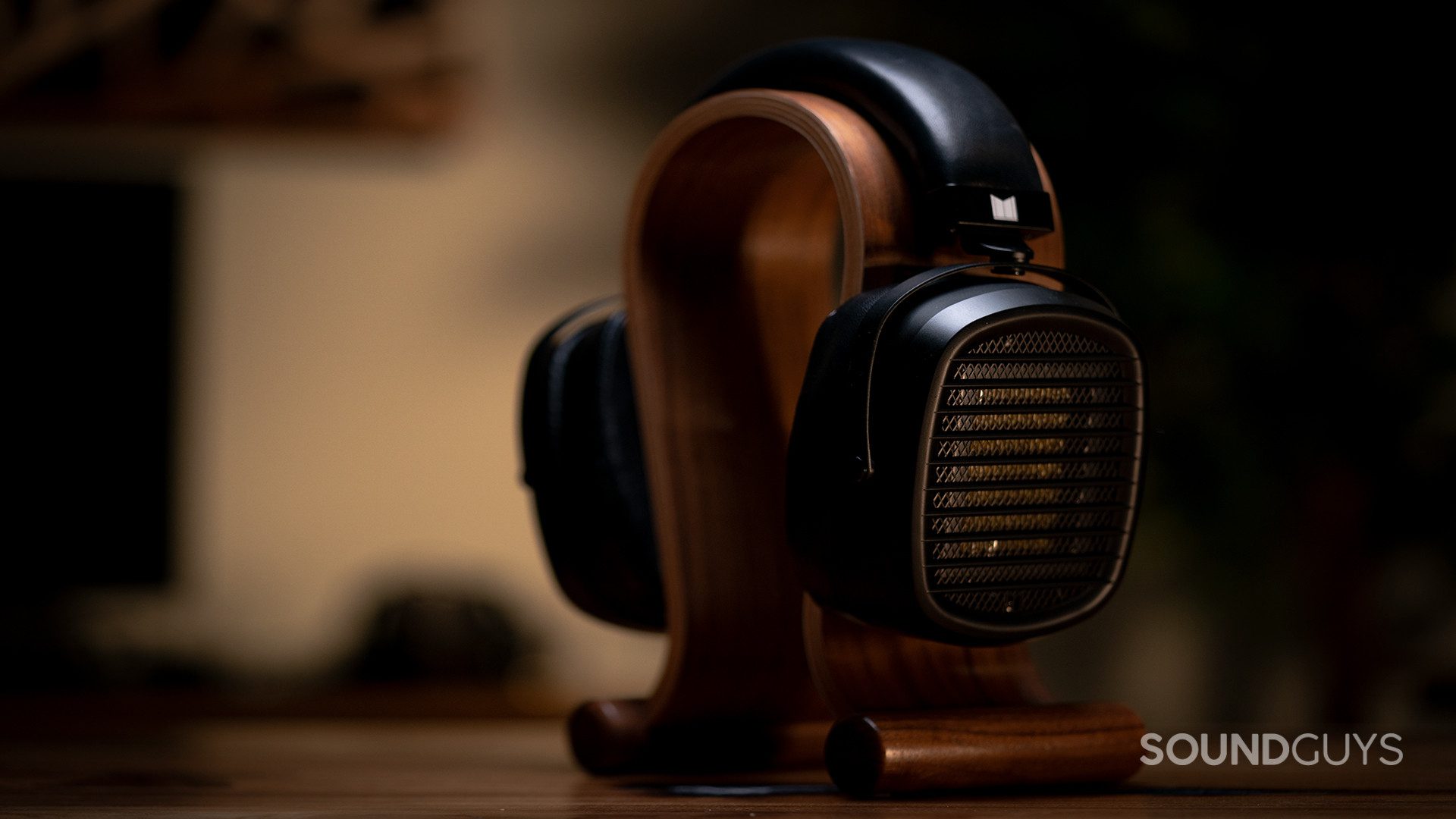
Monolith by Monoprice AMT
Bargain brand Monoprice is known for its more-affordable products, as it controls the supply chain for the wares it sells. In the last few years, Monoprice has made a splash by stepping up its game in the personal audio sphere, offering an entire sub-brand (“Monolith”) of audiophile-oriented products. Not playing cautiously, Monoprice brought its most ambitious headphones to date to market: the Monolith by Monoprice AMT.
Sporting air motion transformer (AMT) drivers, premium build quality, and a price tag that’s a step lower than its closest competitors, the Monoprice Monolith AMT is at least worth a look, but is it worth a buy?
Editor’s note: the scoring is based on the un-equalized measurements, and not the equalized measurements. Your experience will diverge wildly from our assessment if you apply our suggested corrections, or your own!
Who is the Monoprice Monolith AMT for?
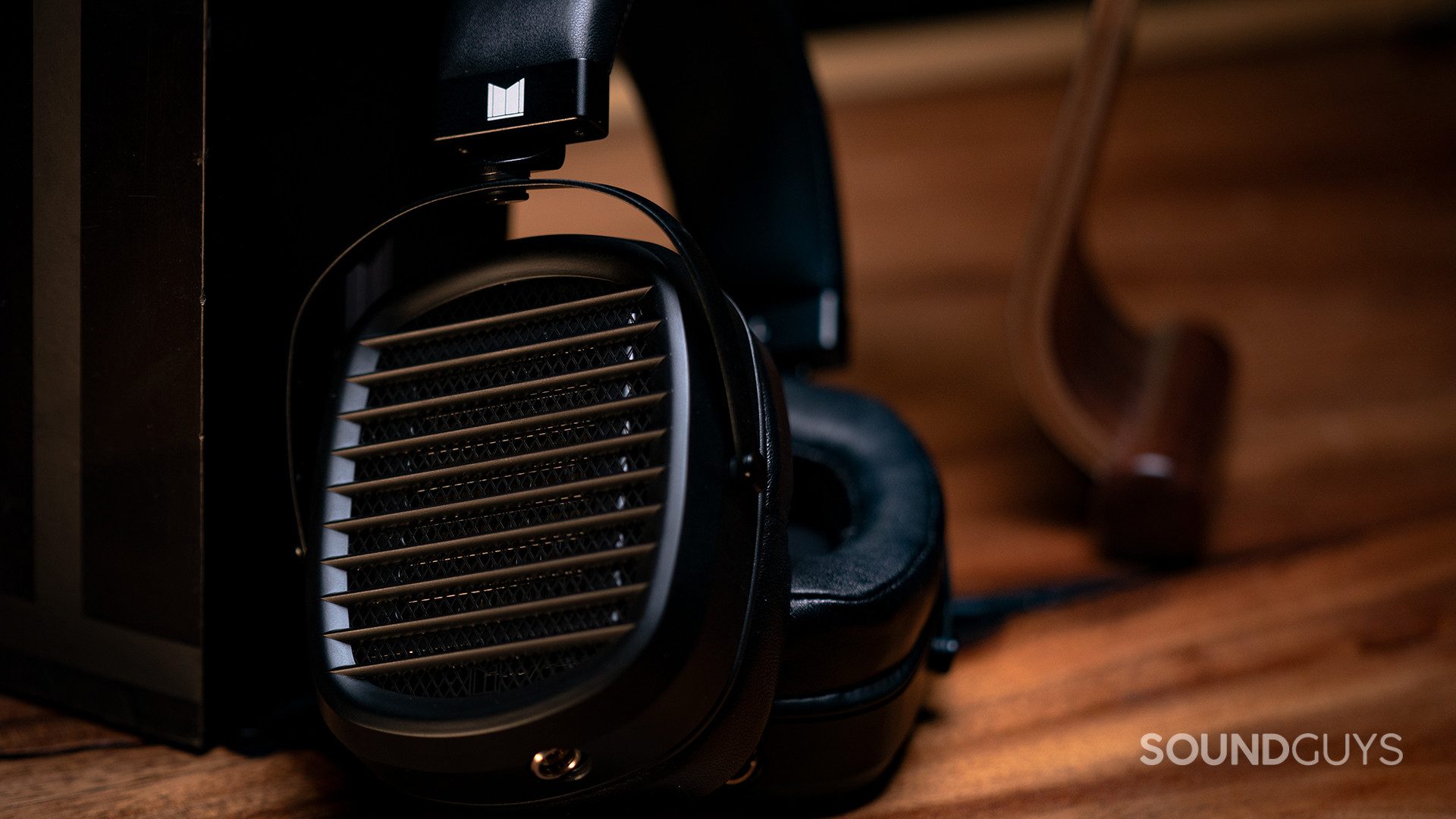
If you’re an audiophile with a bit of cash to blow, headphones with air motion transformer drivers are a really cool addition to any collection. However, this is one of those times where you have to be really into collecting headphones to expand out to niche products like the Monoprice Monolith AMT. That said, this is likely the most affordable way to grab an AMT headset, so there’s that.
What is the Monoprice Monolith AMT like to use?
If you’re new to high-end headphones, be aware that many top-end products are purpose built for sound quality and little else. You will find no bells and whistles here, just headphone drivers and a comfortable—albeit massive and heavy—wrapper for them.

From start to finish, the story surrounding the Monoprice Monolith AMT is, “Wow this thing is huge.” The headphones are heavy, they take up a ton of space, and the fat cable is very difficult to ignore. Truly, these are headphones built to stay at home in a more serious setup (or, by the computer). To that point, you’ll need a decent amount of power from a headphone amplifier for this beast. Its somewhat low sensitivity means you aren’t going to have a lot of headroom if you like to listen a little on the loud side. It’s not really necessary for normal listening, but it’s something to keep in mind.
Each ear cup has a 4-pin mini-XLR connector, so you can replace the cable should something break or you find something you like the look of better. You don’t need to upgrade the cables here, so keep that cash on hand for a stand instead. The Y-split cable comes wrapped in fabric and terminates in a 1/4-inch TRS plug. Inside the box is an adapter for use with 1/8-inch (3.5mm) plugs, so no trips out to the electronics hobby shop.

Plopping this on your head, you may wonder if you’ve got the right fit. The Monolith AMT is made for big heads—even on the smallest setting, a few people in our office have trouble keeping it secure, so be aware that this may not fit you. If your noggin is big enough, the very thick ear padding and chunky band padding will be a welcome friend, as weight is an issue at 630g. You’re definitely not going to forget you’re wearing the Monolith AMT unless you have considerably stronger-than-normal neck muscles.
Unlike a dynamic driver, ribbon tweeter, or planar magnetic driver, an air motion transformer (AMT) driver works a bit like a strange accordion, or bellows. If you were to look at a cross-section, it would look a bit like the inside of corrugated cardboard. Because the diaphragm isn’t a flat plane, there’s much more surface area moving air than your garden-variety consumer headphone dynamic drivers, which can use cone or flat plane shapes. Consequently, the design of an AMT driver means that the diaphragm doesn’t need to move as far to move a sufficient volume of air to create sound, in turn reducing the time it takes for the driver to accomplish this task. This has benefits in terms of reproducing high-frequency sound, as well as avoiding some types of audible artifacts introduced by dynamic drivers.
In particular, it leads to far less distortion by design. While we don’t post total harmonic distortion (THD) plots here unless there’s a big problem, the Monoprice Monolith AMT posts lower measures than just about all of the higher-end headphones we’ve measured thus far. This is expected—it’s one of the main advantages of the design of the driver.
We will point out, however, that the use of an AMT driver in headphones is unusual, as most companies that use this type of transducer use them as mid-range speakers or tweeters—and not full-range drivers. However, Monoprice does a decent job here, as you’ll see below.
How does the Monoprice Monolith AMT connect?
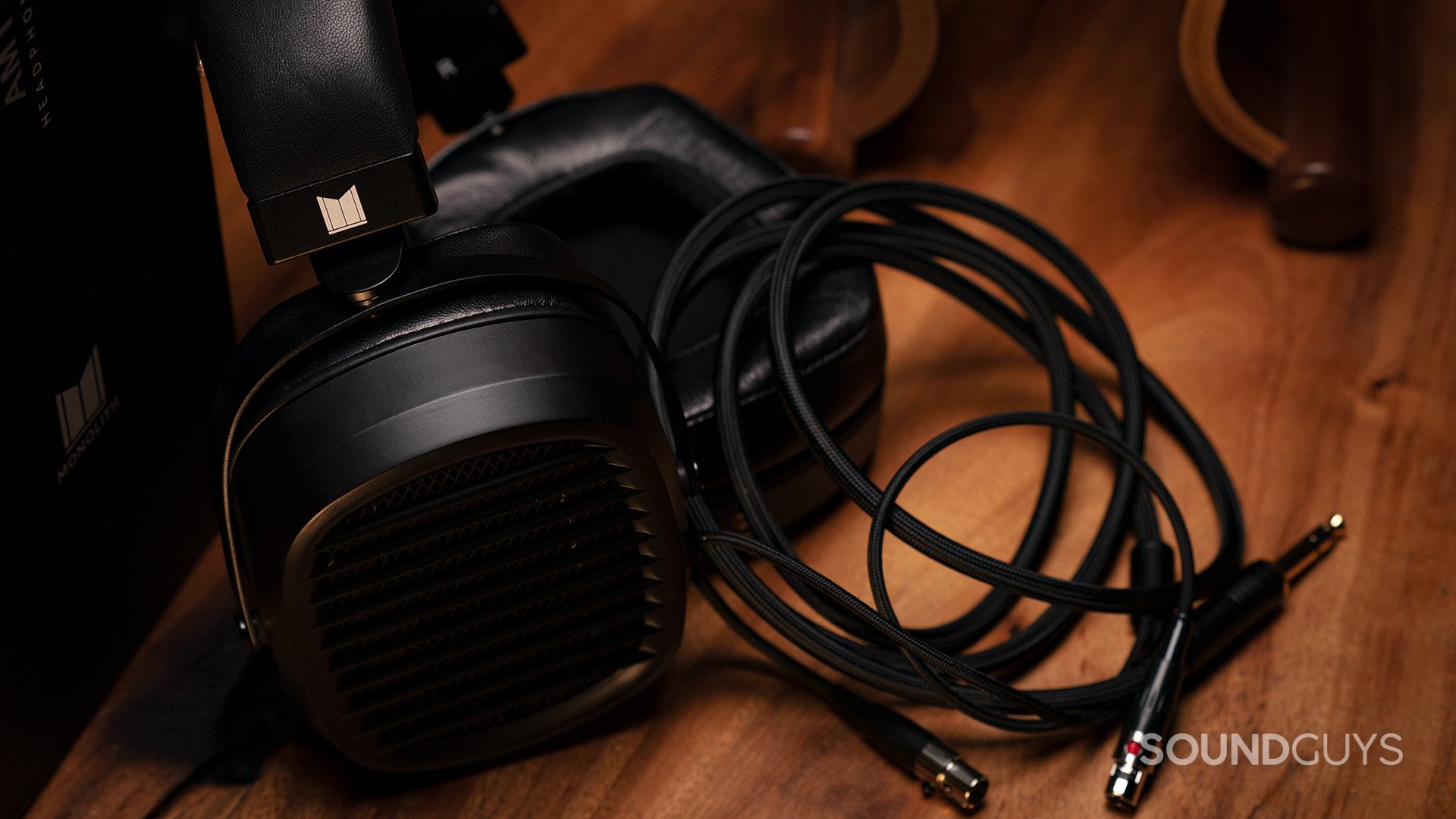
Like most high-end headphones, the Monoprice Monolith AMT connects to a source via a physical connector. In this case, we’re talking about a 1/4-inch TRS plug. Though the cable itself connects to the ear cups via 4-pin mini-XLR, you won’t need a source with that.
| Spec | Value |
|---|---|
Impedance | 32Ω |
Sensitivity | 90dB/mW |
Max power | 10W for 200ms |
Connection type | 4-pin mini XLR/1/4" headphone connector |
Inside the packaging is a 1/4-inch to 3.5mm adapter, if you need to use the smaller plug for whatever reason. Popular USB interfaces like the Scarlett 2i2 that have a 1/4-inch (6.5mm) jack already won’t require this adapter, though smaller amplifiers will.
How does the Monoprice Monolith AMT sound?
Out of the box, the Monoprice Monolith AMT doesn’t sound amazing, but it is very fixable.
If you were to connect the Monoprice Monolith AMT to your source without any equalization (EQ), you would notice right away that vocals are a bit tough to sort out in some mixes, and cymbals are similarly off-sounding. That’s because these headphones really don’t emphasize the range of sound most headphones do, between 1-6kHz. This is an important range for your brain to parse things like speech intelligibility, and to pick out different sounds when there’s a bunch of stimuli in the world around you.
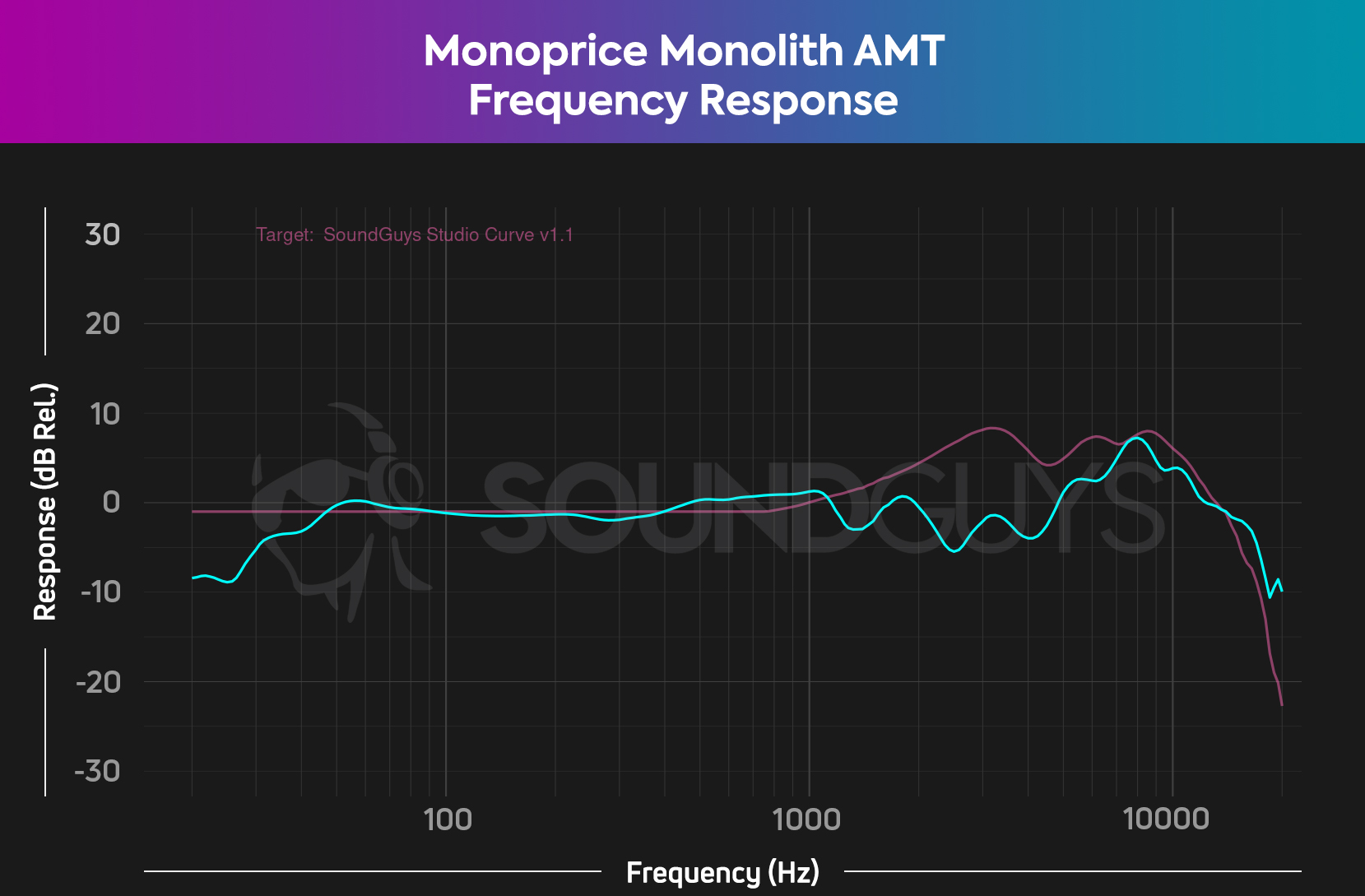
Headphones typically boost widely around 3kHz, to replicate the way our physiology affects the way we hear sounds around us—this is one of the main features of our target curves for headphones—making them sound more natural. Our brains expect to perceive the world a certain way, and sometimes products will inadvertently mess with that a bit.
Because this pair of headphones is very much a hobbyist item, we have no issue with pulling our punches on something that needs a little equalization. It’s not really a huge deal for someone willing to put in the effort to support such a niche device. You could also just use a program like Equalizer APO and mess around that way. Truly, most equalizer platforms will work well with a few simple alterations.
That under-emphasis in the highs is really tough to deal with because it’s so extreme, and for that reason, we suggest using the Monoprice Monolith AMT with an amplifier. Otherwise, making the aggressive cuts to emphasis are going to lead to loudness issues down the line.
We recommend setting your preamp to -6dB, then matching the line in the plot thumbnailed to the left (click to enlarge) as best you can. Keep in mind, it’s just a starting point, and that you should avoid exceeding any boosts of 6dB so you don’t introduce any clipping. Anything below 100Hz and above 12.5kHz can be ignored, but in general, you’re going to want to get that weird drop in the 2-5kHz range to be as boosted as possible in relation to the rest of the frequencies there. That’s the main point. Really, even if you’re not comfortable making deep cuts elsewhere, whatever you can do to rectify the under-emphasis in this range will pay dividends.
Normally we wouldn’t advise making such aggressive cuts, but since Monoprice Monolith AMT’s distortion is so low, it’s a little more forgiving when you crank the overall levels. There are limits to this—definitely keep your levels in check, and don’t crank it too hard. While we never ran into distortion problems with the equalization above, it’s possible that you’d run into some issue in the sub-bass.
Be sure to fiddle with things to bring the sound closer to your liking, and definitely don’t take our suggestion as gospel: it’s merely a starting point to bring the headphones to our target. Bass lovers may elect to take a lighter hand on cutting the lows, and that’s okay! Headphones are supposed to be fun.
Because AMT drivers are really quick to move in comparison to voice coil drivers, you may notice a difference in sound quality that’s difficult to put your finger on. That’s because, with faster moving drivers, you don’t often run into the artifacts introduced by slower dynamic drivers. Rumbles in movies won’t have that weird extra lag they sometimes have on more cheaply-built headphones. Additionally, if you hear distortion, it’s almost assuredly in the source material itself (or somewhere else in your signal path) because the distortion we measured is among the lowest we’ve seen in any headphones we’ve tested—so much so that it dips below our predefined chart area in a few places.
If there’s an audible shortcoming with the Monoprice Monolith AMT, it doesn’t really come from the drivers: it’s the tradeoff made by having an open-back headset. The AMT drivers radiate sound in both directions so that open back is necessary to avoid having to dampen the sound coming from the other side. This has the upside of making music sound more natural in your listening sessions, but it also has the drawback of being really poor at blocking outside noise.
The Monoprice Monolith AMT has what are called “open backs,” meaning there’s no attempt to enclose the rear of the sound-making elements of the headphones in plastic, wood, or metal. Consequently, these headphones not only let everyone around you hear what you’re listening to, but they also let in a ton of outside noise.
This is why we recommend this stays by the computer and never leaves your desk—if you try listening to this set of headphones in noisy environments, the only predictable thing about your listening experience is that you’ll be cranking the volume to drown out noise. That’s bad for a number of reasons, but it’s even worse when everyone else can hear your music too.
Should you buy the Monoprice Monolith AMT?
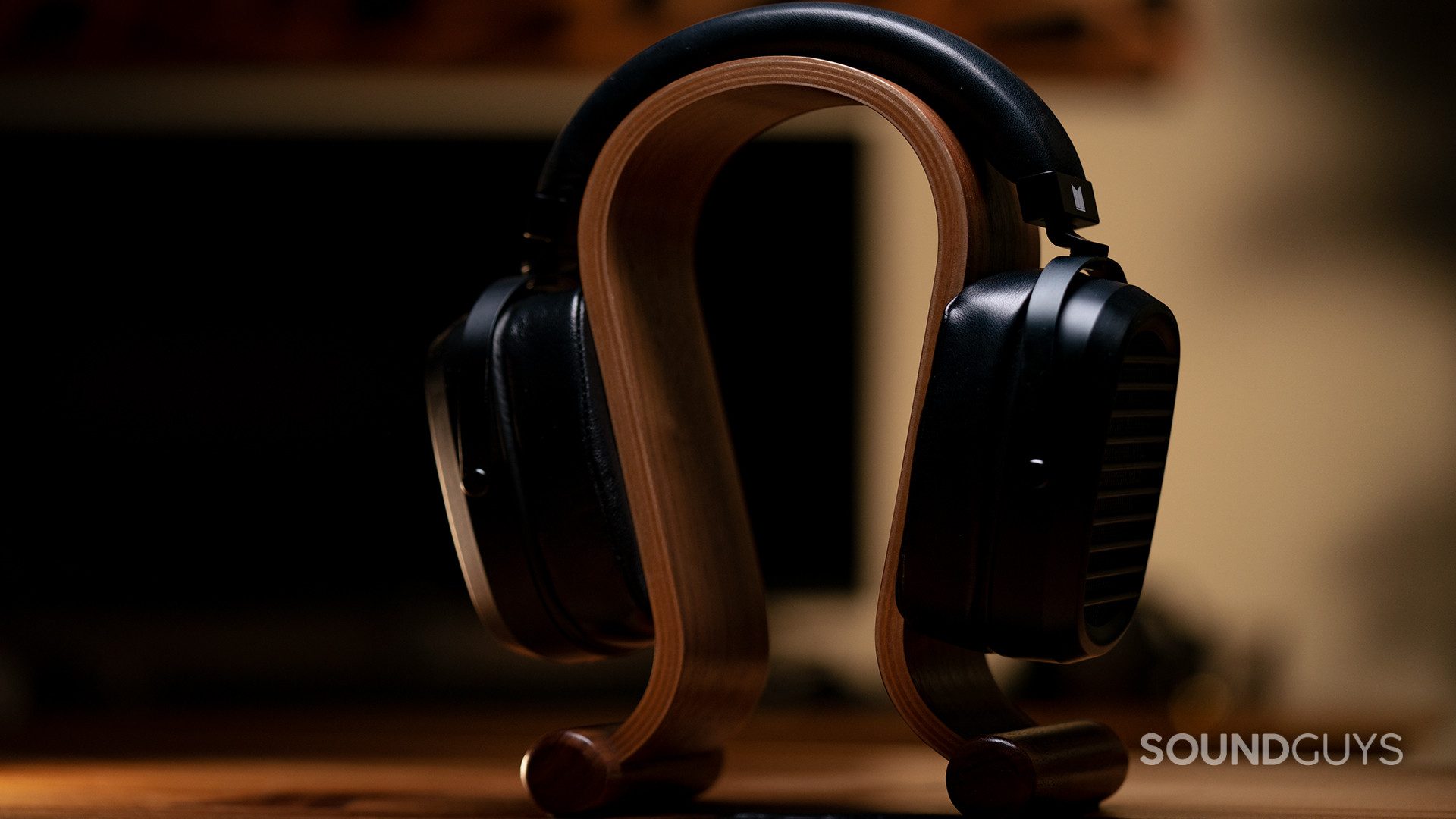
If you’re looking to a stranger on the internet to tell you whether or not you should buy the Monolith by Monoprice AMT, you’re asking the wrong question. It’s worth it as a curiosity, or as a test drive for other AMT headphones, but it’s definitely not something you get as the last headphones you ever buy. This is very much an enthusiast hobby piece for when you want to get a little crazy with your setup.
The Monoprice Monolith AMT is impressive and is a great gateway to the world of high-end audio. However, it’s still a “halo” product meant to establish the brand rather than be a compelling buy right off the bat. There’s nothing inherently wrong with it—if it leads to increased commercial availability of AMT drivers, more power to Monoprice, it’s reason enough to praise these cans.

What should you get instead of the Monoprice Monolith AMT?
While the Monolith AMT is a fine headset, you’ll probably want to save some money by grabbing a pair of mid-range planar magnetic headphones instead, especially if you don’t want to EQ your headphones as much as you would have to with the Monoprice Monolith AMT. To that end, we suggest taking a good hard look at other offerings from HiFiMan, ADV.Sound, and even Monoprice’s other Monolith offerings. While most planar magnetic headphones are also quite heavy, they don’t really compete with the Monoprice Monolith AMT in that department—so your neck will thank you if you go that route.
Frequently asked questions about the Monolith by Monoprice AMT?
Yes, Monoprice makes it easy to replace the ear pads, so you can upgrade them to a third-party pair of cushions if you’d like. You get two pairs of memory foam ear pads to start: lambskin and velour.